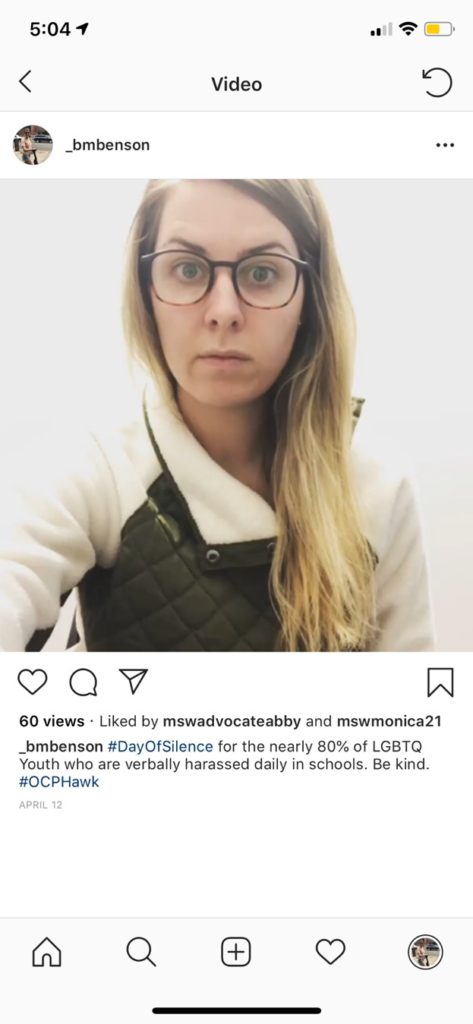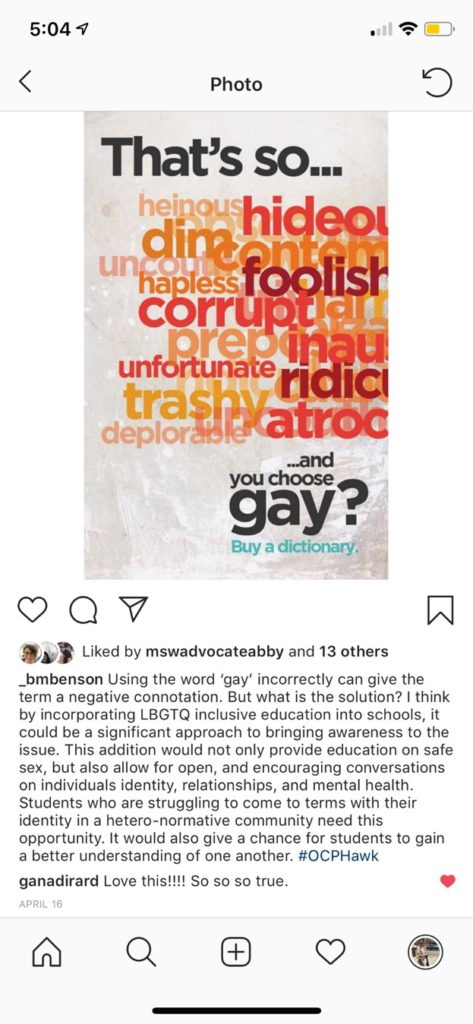Digital Advocacy in the Social Work Classroom: Students speaking out online


Editor’s Note: Julia Kleinschmit is a clinical associate professor in the School of Social Work at The University of Iowa, and Breanne Benson is a currently MSW student in the School of Social Work at The University of Iowa. In this blog post, Julia writes about an assignment that uses social media to promote advocacy skills and professionalism among social work students. Breanne offers her experience with the assignment as a student and reflects on how she grew her skills as a future social worker. Julia can be found on LinkedIn, and Breanne is on Instagram at _bmbenson.
Addressing Technology in Changing Social Work Environment
The Council on Social Work Education’s (CSWE) Competency 1: Demonstrate Ethical and Professional Behavior requires social workers to use technology ethically and appropriately to facilitate practice outcomes. Many have focused on the need for confidentiality in electronic communication and social media boundary management. These are important issues, but at the University of Iowa’s School of Social Work, Megan Gilster, Stephen Cummings, and I believed we could also teach MSW students to use their online identities and social media as powerful tools for effective advocacy.
Recognizing the Importance of the Online Self in Making Change
In our Organization and Community Practice (OCP) course, students work in groups to conduct a community needs/strengths assessment to identify an issue, and then draft intervention and evaluation plans. . In 2016, we started requiring each student to use social media to communicate findings from their group’s needs/strengths assessment to advocate for a cause or a policy. We articulated the importance of learning these skills in the assignment description and learning outcomes:
Effective use of one’s online self is an important skill in macro social work practice. Social media and technology are increasingly important components of our personal and work lives. This assignment requires students to utilize ethical culturally sensitive communication in a social media platform in order to advocate for social justice. By the end of this assignment, students will be able to:
- Utilize ethical principles in all aspects of one’s practice with organizations and communities;
- Demonstrate respect for and the use of culturally sensitive approaches in working with diverse groups;
- Apply research to understand and analyze the issues facing organizations and communities;
- Utilize advocacy skills to educate, engage, mobilize and/or influence community members and decision-makers;
As a program, we used this assignment in every section of OCP to assess student learning for Competency 1 and Competency 8: Intervene with Individuals, Families, Groups, Organizations, and Communities.
Assignment Details
Students can select their preferred social media platform for the assignment, choosing from Twitter, LinkedIn, Facebook, Instagram or YouTube. We encourage students to create a new, professional account for the course, to carefully cultivate that account and connect with other professionals on social media to make posts more impactful. All social media contributions must include the hashtag #OCPhawk (OCP for the course, hawk for the Iowa Hawkeyes, our institution’s mascot) for grading. The hashtag (which each platform hyperlinks) makes students’ posts more searchable on the web. We have different expectations for each platform, detailed below:

Social Media Advocacy: Preparing and Supporting Students
Class discussions in early and mid-semester focus on social media ethics, creating a professional presence, and aspects of successful social media use. Students read about issue advocacy, issue framing, and persuasion. They watch three video tutorials about social media, created by Steve Cummings. Each video has content on all the social media platforms, organized by topic: written and unwritten rules; using social media professionally and ethically; and strengths, limitations, and increasing the impact of your social media contributions.
Grading the Assignment
The assignment is due at the end of the semester. Students upload screenshots of posts and write a one-page reflection paper to assess of the purpose, effectiveness, and impact of their social media advocacy. We grade students on contribution completion, effectiveness, ethicality regarding the information presented, and evidence they provide to show their advocacy’s impact. Here is a link to the assignment rubric.
General Student Feedback and Lessons Learned
We have used this assignment for three years and overall, we find it accomplishes our goal of helping students to learn the basics of advocacy. Some students express initial hesitancy about the assignment including being new to social media in general, the risk of backlash for their advocacy, and negative experiences with social media. Their reflection papers show students grow to appreciate social media as a powerful tool. Students report feeling more connected with others advocating for similar issues and they have plans to use social media in future practice. Almost universally, they wish they had started the assignment earlier to have more impact. More specific information on student gains in knowledge and adjustments we made to the assignment can be found in our publication in the Journal of Social Work Education, which you can access here (Gilster, Kleinschmit, Cummings & Ronnenberg, 2018).
One Student’s Experience – Breanne Benson
What were your first thoughts about this assignment?
When I initially learned about this assignment, I was apprehensive. Showing your vulnerability by posting on social media is terrifying. If you would have asked 13-year-old Breanne to complete this assignment she would have jumped in headfirst, but 25-year-old me was less than enthused. I first joined the social media world when I was in 8th grade. Like many junior high students, I posted all the pictures, statuses, and quotes that I felt described my feelings for the day. However, the older I got, the less I posted about my personal life. Controversial conversations on social media became more frequent and I did not want to be involved. To me, social media become something more sacred to keep to myself. I did not want to give power to others to critique my opinions, accomplishments, pictures, my life. I also do not like how people use social media to tear each other down, rather than have educate each other about issues.
When I initially created my new Instagram account for the assignment, many of my original followers from my personal account began texting me asking if I had created a new account. When I explained what the new account was for, it opened a new dialogue between us. Many of my followers were unaware I was in school again or what for. I ended up gaining more followers than I had expected. I knew the population I wanted to post about, LBGTQ youth, was controversial for many in my community, including my own Catholic family. I was concerned about possible comments made on the posts by my followers, and how to best navigate a professional response. When I began researching what I wanted to post, I came across the picture of the couple burying the Pride flag in the sand and knew I wanted to figure out a way to incorporate that into a post somehow. For me it was a realization that for some individuals, the discrimination never goes away even when one is on vacation.
How did your experience with this assignment change over time?
I ended up loving this assignment. As the assignment progressed, my apprehension dwindled and I became more excited about searching for inspiration for the next post. I looked forward to the questions or responses I would get about the newest post. Those in my life who followed my new account seemed to enjoy reading the captions and learning more about LGBTQ youth. The post that seemed to get the most feedback was a post about how word ‘gay’ is often used as an insult or in a derogatory way. . For some, it is a word that is used so loosely and in their everyday conversations that they were not even aware how frequently it was being used or the affect it really had. Another post I heard a lot about was the video of myself sitting silently representing the #DayOfSilence. This movement was created to spread awareness about how bullying and harassment affects LGBTQ students. My followers seemed to enjoy reading the captions and learning more about LBGT youth. The positive responses I received from my followers gave me confidence, encouragement, and empowerment. I liked seeing that I could see my platform to advocate and educate. Here are some screenshots of my Instagram posts:
What steps did I take to learn about how to do advocacy using social media?
I planned my posts in order to get my followers thinking. I wanted them to see the post, read the caption, and have an “aha!” moment. I also realized as someone who has been using social media for thirteen years, I needed to create each post in a way that would hold my follower’s attention. Clear, concise, and to the point. “No extra fluff” as one of my professors always says. I researched and read topics that discussed topics I thought would appeal to my specific followers. Before this class I had not done any sort of work or research around LBGT youth, so for me, I also had a few “aha!” moments.
How do you plan to use skills from this assignment in professional practice? Or how have you already? After the assignment was completed I did not post on that Instagram handle, but I feel like I will post more in the future. This assignment gave me a new perspective and showed me that I cannot assume I will receive backlash for the posts. I have more of an open mind towards posting in my professional career.
Would you recommend this assignment to other social worker educators for their classes? Why?
I would recommend this assignment to other social work educators. It really pushed me out of my comfort zone, which I think is a big step in growing as a student. It also allowed me to continue to grow my knowledge about a community I knew very little about.
What are your thoughts?
ocial work educators, are you doing a similar assignment in your own classroom? How is it different from our assignment? Social Work students, what recommendations would you have for this assignment? Please leave your comments in the section below. For more information, please contact Julia Kleinschmit at julia-kleinschmit@uiowa.edu or @JuliaKleinschmi
References:
Gilster, M. E., Kleinschmit, J. L., Cummings, S. P., & Ronnenberg, M. M. (2018). Teaching Note—Pick Your Platform: Social Media Advocacy Skill Building. Journal of Social Work Education, 0(0), 1–9. https://doi.org/10.1080/10437797.2019.1593903
How to cite this Post: Kleinschmit, J. & Benson, B. (2019, August 7). Digital Advocacy in the Social Work Classroom: Students speaking out online [Blog Post]. Retrieved from https://laureliversonhitchcock.org/2019/08/07/digital-advocacy-in-the-social-work-classroom-students-speaking-out-online/




